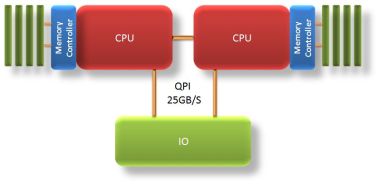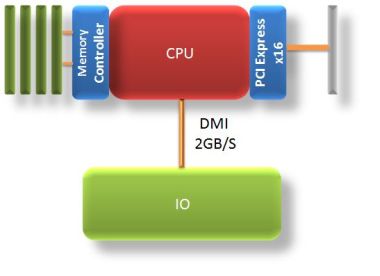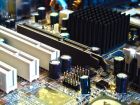Intel QPI
What is the new Intel Quick Path Interconnect?
In this section we will discuss the Intel QPI (Quick Path Interconnect) that all but replaced the aging Front Side Bus (FSB).
We will also have a look at the DMI (Direct Media Interconnect) from Intel and what the differences between these 2 technologies are.
This topic can be a complicated affair, but I will keep it short and simple.
I think it's necessary for us to understand just a little more on these new technologies to see where Intel was and where it's going to.
The Basics
The Intel QuickPath Interconnect (QPI) is Intel's latest technology to connect CPU, memory and IO together. It basically replaced the old FSB or Front Side Bus architecture.
It uses a point to point high speed interface that connects CPU's to the IO controller in a direct crossbar fashion.
This means high speed transfers between CPU's and IO.
With this new architecture, Intel decided to not use a separate memory controller, but instead to integrate the memory controller on the CPU.
Intel QuickPath Interconnect
This makes accessing memory, that's in the CPU's banks, much quicker than the old FSB architecture. It gives you a throughput of about 25GB/second between CPU's and IO.
The cache coherency model has also been updated to allow less hops if a CPU needs to access data from another CPU's memory or cache.
The Intel QPI will be mostly used in server environments or very high end desktops. Expect to pay if you intend to buy a motherboard using the Intel QPI.
What is the DMI (Direct Media Interface)?
So, Intel QPI is for high end stuff such as servers. What do they use in normal run of the mill desktops?
Because 25GB/second would be an overkill on a desktop with one CPU, the DMI or Direct Media Interconnect has been developed.
It only uses 2GB/second bandwidth to connect CPU to the IO controller. But this is more than enough.
A memory controller is also integrated in the new architecture. The Intel Core i3, i5, lower end i7 and Atom range will make use of the DMI.
The higher end Core i7's will use the QPI for crossbar connections to other CPU's and to the IO hub.
They also built in a graphics controller on the CPU. The advantage of this is that the CPU has now direct access to a PCI express bus and need not go through the IO hub.
Intel Direct Media Interconnect
To keep track of all these interconnects and buses, Intel uses code names to identify the different technologies.
For example, they use a code name called "Lynnfield", for the desktop Core i5 and i7 that uses 4 cores and the LGA (Land Grid Array) socket 1156. This does not use the Intel QPI but the DMI. With this architecture, the CPU has a memory controller and a x16 lane PCI express controllers built in to it.
The x16 lanes can be either one x16 lane PCI express slot or 2 x8 lane PCI express slots.
The "Lynnfield" and "Clarkdale" architectures are the most common used today in desktop PC's.
Will I ever have a PC that's up to date?
Good question. Intel is planning to release their new micro architecture called "Sandy Bridge". This will be the next big thing, so your new i5 might already be aging.
Don't stress. That's how technology goes. These manufacturers are in constant battle with each other to produce the next big thing.
Remember one thing, you bought your PC to do a specific job. As long as you can do that job with your PC, it doesn't matter what new thing they develop.
When a new architecture comes out, you don't have to upgrade immediately. Use you PC or laptop for the job it was bought for and don't sweat the new technology.
When you buy a PC or laptop, look at the specifications and look at the options to upgrade at a later stage.
Maybe you only want to start with 2GB of memory. Make sure that you can upgrade later to 4GB or more. Have a look at the manual and make sure you understand what the motherboards capabilities are for future upgrades.
Return from Intel QPI to Computer Bus
Back to What is My Computer



